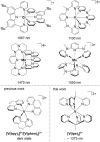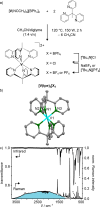A Near-Infrared-II Luminescent and Photoactive Vanadium(II) Complex with a 760 ns Excited State Lifetime
- PMID: 40462271
- PMCID: PMC12186473
- DOI: 10.1021/jacs.5c04471
A Near-Infrared-II Luminescent and Photoactive Vanadium(II) Complex with a 760 ns Excited State Lifetime
Abstract
Ruthenium and iridium are key components in the most important applications of photoactive complexes, namely, light-emitting devices, photocatalysis, bioimaging, biosensing, and photodynamic therapy. Especially, near-infrared (NIR) emissive materials are required in fiber-optic telecommunications, anticounterfeit inks, night-vision readable displays, and bioimaging. Replacing rare and expensive precious metals with more abundant first-row transition metals is of great interest; however, photophysical properties and the chemical stability of 3d metal complexes are often insufficient. Here, we tackle these challenges with a nonprecious metal polypyridine vanadium(II) complex that shows emission above 1300 nm with excited state lifetimes of up to 760 ns. Strong light absorption in the visible spectral region and exceptional stability in the presence of oxygen enable photocatalysis in water and acetonitrile using green to orange-red light for excitation. This study unravels a new design principle for NIR-II luminescent and photoactive complexes based on the abundant first-row transition metal vanadium.
Figures






Similar articles
-
Antidepressants for pain management in adults with chronic pain: a network meta-analysis.Health Technol Assess. 2024 Oct;28(62):1-155. doi: 10.3310/MKRT2948. Health Technol Assess. 2024. PMID: 39367772 Free PMC article.
-
EORTC guidelines for the use of erythropoietic proteins in anaemic patients with cancer: 2006 update.Eur J Cancer. 2007 Jan;43(2):258-70. doi: 10.1016/j.ejca.2006.10.014. Epub 2006 Dec 19. Eur J Cancer. 2007. PMID: 17182241
-
Drugs for preventing postoperative nausea and vomiting in adults after general anaesthesia: a network meta-analysis.Cochrane Database Syst Rev. 2020 Oct 19;10(10):CD012859. doi: 10.1002/14651858.CD012859.pub2. Cochrane Database Syst Rev. 2020. PMID: 33075160 Free PMC article.
-
Near-Infrared-II Fluorescent Probes for Analytical Applications: From In Vitro Detection to In Vivo Imaging Monitoring.Acc Chem Res. 2025 Feb 18;58(4):543-554. doi: 10.1021/acs.accounts.4c00671. Epub 2025 Feb 5. Acc Chem Res. 2025. PMID: 39907648 Review.
-
A manganese(I) complex with a 190 ns metal-to-ligand charge transfer lifetime.Nat Commun. 2025 Aug 22;16(1):7850. doi: 10.1038/s41467-025-63225-4. Nat Commun. 2025. PMID: 40846841 Free PMC article.
Cited by
-
Efficient Red Light-Driven Singlet Oxygen Photocatalysis with an Osmium-Based Coulombic Dyad.Angew Chem Int Ed Engl. 2025 Aug 25;64(35):e202502840. doi: 10.1002/anie.202502840. Epub 2025 Jul 15. Angew Chem Int Ed Engl. 2025. PMID: 40549962 Free PMC article.
References
-
- Hockin B. M., Li C., Robertson N., Zysman-Colman E.. Photoredox catalysts based on earth-abundant metal complexes. Catal. Sci. Technol. 2019;9:889–915. doi: 10.1039/C8CY02336K. - DOI
-
- Dorn, M. ; East, N. R. ; Förster, C. ; Kitzmann, W. R. ; Moll, J. ; Reichenauer, F. ; Reuter, T. ; Stein, L. ; Heinze, K. . d-d and charge transfer photochemistry of 3d metal complexes. Comprehensive Inorganic Chemistry III, Elsevier, 2023, 707–788 10.1016/B978-0-12-823144-9.00063-7 - DOI
LinkOut - more resources
Full Text Sources
Miscellaneous

